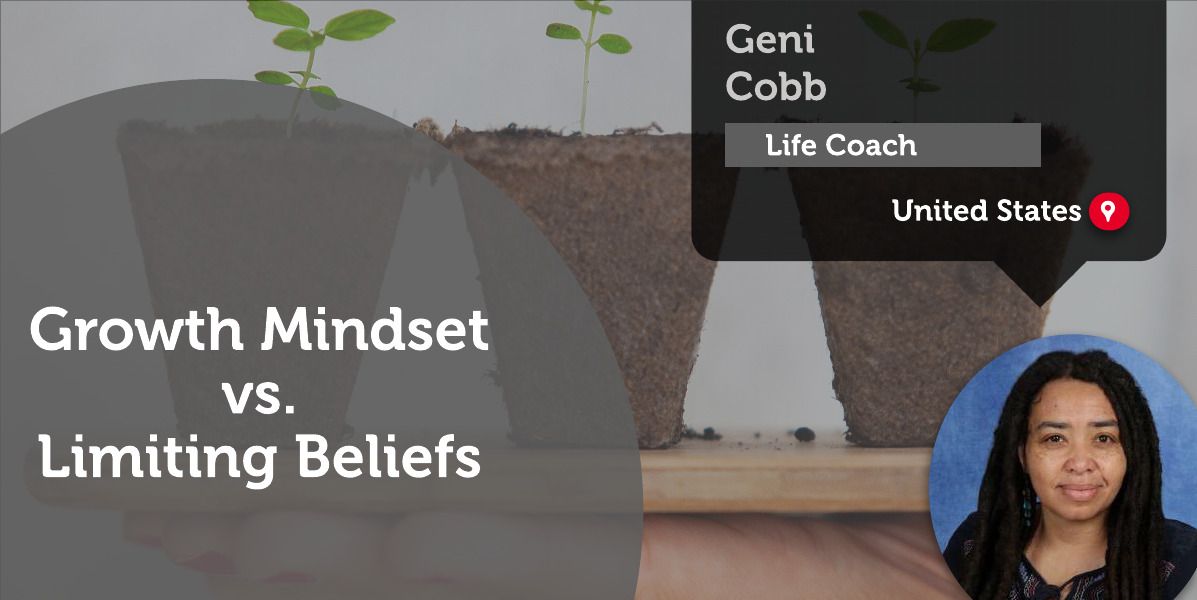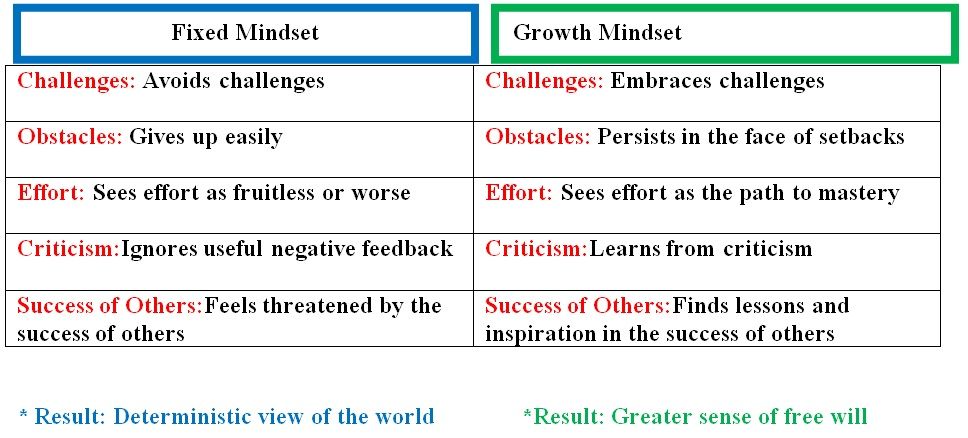A Coaching Power Tool By Geni Cobb, Life Coach, UNITED STATES

A Growth Mindset vs. Limiting Beliefs Power Tool That Can Benefit Adolescents and Young Adults in an Individual or Educational Setting.
I’m not afraid of storms, for I’m learning to sail my ship. Louisa May Alcott
The ability to work with students can be positively rewarding but it can have its challenges. Behaviors and habits can be hard to break, but not impossible. Students have the capabilities to work towards a more positive mindset called a growth mindset and also work on deleting the possible limiting beliefs that may be keeping our young students from achieving their true potential.
Growth Mindset vs. Limiting Beliefs Explanations
What Is Growth Mindset?
“In a growth mindset, people believe that their most basic abilities can be developed through dedication and hard work—brains and talent are just the starting point. This view creates a love of learning and a resilience that is essential for great accomplishment” (Dweck, 2015, as cited by James Clear, 2018). In other words, it is the belief that we as humans continue to develop through a system of beliefs that we can achieve and create an increasing learning behavior that leads to accomplishments. More specifically regarding students, Carol Dweck(2014) states that “in a growth mindset students understand that their talents and abilities can be developed through effort, good teaching, and persistence. They don’t necessarily think everyone’s the same or anyone can be Einstein, but they believe everyone can get smarter if they work at it” (As cited by Mindsetworks, 2017). Student mental development continues to grow as students increase their response to the energy of continuing forward by putting their efforts into studying or trying new ideas. Students must have this belief as it is the change needed for a growth mindset to happen. A growth mindset is for all people; this includes adults and all children and is adaptable and pliable for all ages. “Growth mindset messaging implies that everyone can succeed even when challenges arise or experience is lacking and represents a potent and implicit message that development is possible”(Burnette JL, Pollack JM, Forsyth RB, et al., 2020, p. 879).
What Are Limiting Beliefs?
“In a fixed mindset, people believe their basic qualities, like their intelligence or talent, are simply fixed traits. They spend their time documenting their intelligence or talent instead of developing them. They also believe that talent alone creates success—without effort.” (Dweck, 2015, as cited by Renaissance). People can believe that they don’t have what it takes to succeed, or be smart, or believe in their potential, or they simply may think they are failures. The mind is “unchangeable” no matter what the circumstances are. Author and renowned international speaker Brian Tracy notes that “When a person practices limited thinking they become paralyzed at the start line.” Moving forward becomes an obstacle. Some examples of limiting beliefs according to the Coaching Academy are: fearing greatness, fearing failure, fearing we are not good enough to achieve what we want, fearing success, and fearing rejection. Furthermore, these examples give context to what intelligence means to someone who has a fixed mindset. “Individuals with a fixed mindset believe that their intelligence is simply an inborn trait – they have a certain amount and that’s that” (Dweck, C. as cited by Hochanadel, A. & Finamore, D., 2015).
Neuroplasticity and Growth Mindset
Students are constantly bombarded by outer influences that mold and construct who they are. Their brains are fabricated by the outer influence society has. Dweck describes the brain as a muscle and as “something that gets stronger as it is worked” (Dweck, C. 2006, as cited by the Decision Lab 2021). As the brain is constantly growing and absorbing information, the brain is going through a process in which neuroplasticity is occurring. “Neuroscientists, among others, have emphasized the concept of “neuroplasticity,” as the amazing ability of the human brain to change, adapt and rewire itself throughout our lives. Educating ourselves about the way the brain works directly affects our personal beliefs and expectations about kids’ potential and achievement. When parents and children (as well as teachers) learn about the brain’s amazing potential, their mindsets begin to shift” (Ricci, M. & Lee, M., 2016). Students are constantly revolving and, growing, therefore change in students is vital for coaching to be successful and for the client to be successful in attaining their goal.
Growth Mindset vs. Fixed Mindsets: Two Mindsets
Carol Dweck’s two mindsets, set out to engage in the various ways the mind thinks when it has a fixed mindset vs a growth mindset. In a growth mindset, a person has the will to move forward and onward embracing a more positive and persistent direction to action. In a fixed mindset, a person does not have the will to move on. A fixed mindset is like a closed door and the access to embrace one’s full potential is underscored by negative thoughts / limiting beliefs. The following is her model of the two mindsets that result in either moving through in a positive state of mind or staying stagnant and not able to reform for change.

Letting Go of a Fixed Mindset
The first step of letting go of a fixed mindset is to identify key factors that create the construct of negativity. According to Dan Matthews author of How to Identify Your Limiting Beliefs and Get Over Them, he says, “Limiting beliefs can have several negative effects on you. They could keep you from making good choices, taking new opportunities, or reaching your potential”. Furthermore, he identifies three ways to identify limiting beliefs; “identify and write down your beliefs, assess behavior, and write down areas where you feel challenged”. Identifying beliefs and assessing for negative beliefs can be challenging, but it gives way to being more mindful of when negative beliefs are present. Secondly, assessing the behavior can give insight as to why negative beliefs happen and what triggers those beliefs. Finally, writing about areas that possess challenges is crucial to identifying behaviors that result in negative beliefs. Looking at all three areas of “letting go” will help with identifying limiting beliefs that can impede growth and work towards a new change. In addition, in his talk about How to Overcome Limiting Beliefs, Brian Tracey adds “When a person identifies what’s holding them back, develop an unshakable confidence that a person can do anything they want and make a plan for exactly how to do it, then a person will be free of limited thinking and the person will be on their way to being unstable towards their personal, professional, and financial goals.”. It is important to recognize that mind shifts may take some time and it doesn’t necessarily happen overnight, however it is a daily practice to gain momentum into freeing limiting beliefs and truly committing to be free.
Students, in particular, may have their thoughts deeply ingrained as influence seems to be entrenched in their young lives. Carol Dweck’s research concluded that if children believe that they could grow and thrive, they would stick to those beliefs. The more they stick to the belief of can, the results would show students willing to navigate challenges. Moving into this direction is the work that needs to be constant as it is an art form when rendered in coaching.
Growth Mindset vs. Limiting Beliefs in Coaching
Coaching can be a positive experience as well as a sensitive one. Some clients are ready to jump in, change, and move forward while others may question the change, have limiting beliefs, and be in a stagnant stage. Adolescent students can be a bit finicky about meeting a coach. They may feel like they don’t want to share their insights because trust is not present. Some may feel pressure from friends and may not feel like going for coaching and may rebel along the way.
On the contrary, coaching students can be rewarding. Seeing students in stages where they need that extra push in themselves to move forward can be just the bit of assistance, they needed for themselves. Therefore, establishing trust is key to the relationship-building process. “Clients will come to you because they want to get to somewhere different from where they currently see themselves. That ‘somewhere different’ is their goal. It exists somewhere in their minds, and they may have a very clear idea of what it looks like or they may be somewhat hazy. What they will know is that they don’t have it now” (Kalia, A., 2019). Besides trust, communication is also a key factor in the coaching process. Having students steer their wheel is a powerful onset to what can be a change into the positive or a move into what their goal is. Powerful questioning may lead clients who have limiting beliefs to a more open and fluid coaching session, and with time clients may be open to possibilities and have a growth mindset. “Through working on our transformation, we realize that people can change. We develop a growth mindset, and in the process, we become more capable of helping others do the same” (TTI Success Insights, 2021).
From a coaching perspective, it is important to keep a growth mindset approach as well. Coaching is ever-evolving; therefore, the need to continue personal development and have a growth mindset about expanding knowledge is important. “After all, if you aren’t constantly focusing on your personal development, how can you help your clients?” (Faulkner, J., 2021). As coaches help adolescent students move towards their goals, it is important to remember that the process is intended to move the client from point A to point B. As Angela Dunbar puts it “As a life coach, you are responsible for ‘shaping’ the conversation and moving it towards a clear outcome with committed actions to getting there” (2009). Through moving the conversation to reach goals, as coaches, the wish is for our adolescent clients to move towards a growth mindset and for them to internally learn how to shift limiting beliefs into powerful and positive outcomes. In the process, we too, as coaches must be aware of our limiting beliefs. “The only limits you have are the limits you believe” (Dyer, W., 2021).
References
Burnette JL, Pollack JM, Forsyth RB, et al. A Growth Mindset Intervention: Enhancing Students’ Entrepreneurial Self-Efficacy and Career Development. Entrepreneurship Theory and Practice.
James Clear. Fixed Mindset vs Growth Mindset: How Your Beliefs Change Your Behavior
The Decision Lab. The Decision Lab - Behavioral Science, Applied.
Dunbar A. Essential Life Coaching Skills. Routledge
Dweck, C.S. & Leggett, E.L. A Social-Cognitive Approach to Motivation and Personality
Faulkner, J. Improve Your Coaching Skills with a Growth Mindset. Improve Your Coaching Skills with a Growth Mindset.
The Growth Mindset - What is Growth Mindset - Mindset Works. Mindsetworks.
Growth Mindset Coaching Improves Performance. Integrity Solutions.
Growth Mindset Renaissance.
Hochanadel, A., & Finamore, D. Fixed And Growth Mindset In Education And How Grit Helps Students Persist In The Face Of Adversity. Journal of International Education Research (JIER)
How to Overcome Limiting Beliefs | Brian Tracy. YouTube
Kalia, A. ‘It’s a safety blanket’: why more and more teenagers are relying on life coaches. The Guardian.
Life Coaching Courses, Business Coaching, NLP Training | The Coaching Academy.
Matthews, D. C. How to Identify Your Limiting Beliefs and Get Over Them. Lifehack.
Ricci, Mary Cay; Lee, Margaret. Work & Family Life; New York
Sparks, Sarah D. "Growth Mindset; 'Effects of Teaching the Concept of Neuroplasticity to Induce a Growth Mindset on Motivation, Achievement, and Brain Activity: A Meta-Analysis." Education Week, Gale In Context: Biography
Wayne Dyer - The Official Website of Dr. Wayne W. Dyer.
Webb, K. E. How To Overcome Limiting Beliefs. Keith Webb.